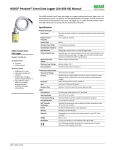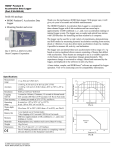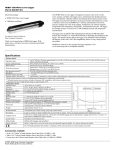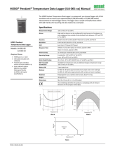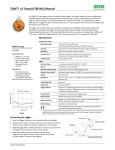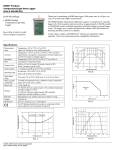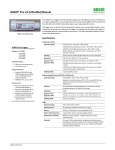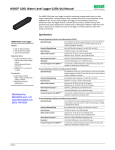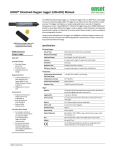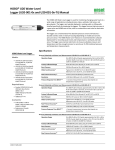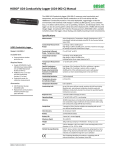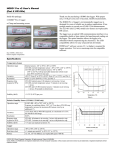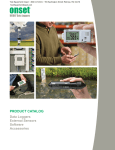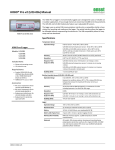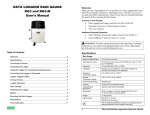Download HOBO Pendant Temperature/Light Data Logger (UA-002
Transcript
HOBO® Pendant® Temperature/Light Data Logger (UA-002-xx) Manual The HOBO Pendant Temperature/Light Data Logger is a waterproof, two-channel logger with 10-bit resolution and can record up to approximately 3,500 (8K model) or 28,000 (64K model) combined temperature and light readings or internal logger events. The logger uses a coupler and optical base station with USB interface for launching and data readout by a computer. Specifications HOBO Pendant Temperature/Light Data Logger Models: UA-002-08 UA-002-64 Required Items: • HOBOware 2.x or later • USB cable (included with software) • Pendant Optic USB Base Station & Coupler (BASE-U-1) • Optic USB Base Station (BASE-U-4) or HOBO Waterproof Shuttle (U-DTW-1) & Coupler (COUPLER2-A) Measurement Range Temperature: -20° to 70°C (-4° to 158°F) 2 Light: 0 to 320,000 lux (0 to 30,000 lumens/ft ) Accuracy Temperature: ± 0.53°C from 0° to 50°C (± 0.95°F from 32° to 122°F), see Plot A Light intensity: Designed for measurement of relative light levels, see Plot D for light wavelength response Resolution Temperature: 0.14°C at 25°C (0.25°F at 77°F), see Plot A Drift Less than 0.1°C/year (0.2°F/year) Response Time Airflow of 2 m/s (4.4 mph): 10 minutes, typical to 90% Water: 5 minutes, typical to 90% Time Accuracy ±1 minute per month at 25°C (77°F), see Plot B Operating Range In water/ice: -20° to 50°C (-4° to 122°F) In air: -20° to 70°C (-4° to 158°F) Water Depth Rating 30 m from -20° to 20°C (100 ft from -4° to 68°F), see Plot C NIST Traceable Certification Available for temperature only at additional charge; temperature range -20° to 70°C (-4° to 158°F) Battery Life 1 year typical use Memory UA-002-08: 8K bytes (approximately 3.5K combined temperature and light readings or events) UA-002-64: 64K bytes (approximately 28K combined temperature and light readings or events) Materials Polypropylene case; stainless steel screws; Buna-N o-ring Weight 18 g (0.6 oz) Dimensions 58 x 33 x 23 mm (2.3 x 1.3 x 0.9 inches) The CE Marking identifies this product as complying with all relevant directives in the European Union (EU). Plot A 9556-K MAN-UA-002 Plot B HOBO Pendant Temperature/Light Data Logger (UA-002-xx) Manual Specifications (continued) 120 40 Pendant 100 Eye 20 Response (%) Depth (m) 30 Waterproof range 80 60 40 10 20 0 -20 0 20 40 0 60 0 200 400 Temperature (°C) 600 800 1000 1200 1400 Wavelength (nm) Plot C Plot D 1. Plug the USB connector on the base station into an available USB port on your computer. Deployment/Mounting The Light Sensor response is roughly cosine dependent with the angle from vertical. Therefore, whether outdoors or underwater, the logger must be mounted horizontally so that the sensor is pointing straight up towards the sky. 2. Insert the logger and the base station into the coupler, as shown in the following diagrams. For BASE-U-1, make sure that the logger is inserted in the end of the coupler that has the magnet, and that the ridges on the base station and logger are aligned with the grooves in the coupler. BASE-U-1 & COUPLER Ridge Attach the logger to a flat surface using glue, a tie, or a rubber band, making sure that the sensor is pointing up. Magnet LOGGER For BASE-U-4 or the HOBO Waterproof Shuttle, firmly insert the optical end of the base station into the D-shaped end of the coupler, and make sure that the ridge on the logger is aligned with the groove in the coupler. To BASE-U-4 or HOBO Waterproof Shuttle Optical communication window LOGGER Connecting the Logger to a Computer The HOBO Pendant logger requires either of the following to connect to the computer: Ridge side down • Pendant Optic USB Base Station & Coupler (BASE-U-1); HOBOware 2.1 or later COUPLER2-A OR 3. If you are using the HOBO Waterproof Shuttle, briefly press the coupler lever to put the shuttle into base station mode. • Optic USB Base Station (BASE-U-4) or HOBO Waterproof Shuttle (U-DTW-1); coupler (COUPLER2A); HOBOware 2.2 or later 4. If the logger has never been connected to the computer before, it may take a few seconds for the new hardware to be detected. If possible, avoid connecting at temperatures below 0°C (32°F) or above 50°C (122°F). 1-800-LOGGERS Coupler lever (for use with HOBO Waterproof Shuttle) 2 www.onsetcomp.com HOBO Pendant Temperature/Light Data Logger (UA-002-xx) Manual 5. Use the logger software to set up the alarms, launch, and read out the logger. Light Measurement The logger measures light intensity in units of lumens per square foot (US) or lux (SI). The light sensor in the Pendant logger measures a much broader spectrum of light wavelengths than are visible to the human eye. Plot D shows that the logger's response extends farther into ultraviolet and infrared wavelengths than the eye's response. This means the logger is useful for sensing wavelengths not visible to the eye, but it also may mean that the logger's readings will not correspond exactly to measurements made with a device having different spectral sensitivity. The light sensor is most useful for determining relative changes, rather than absolute values of intensity. You can read out the logger or check its status while it continues to log, stop it manually with the software, or let it record data until the memory is full. Refer to the software user’s guide for complete details on launching, reading out, and viewing data from the logger. Important: Do not cover the optical communication window in the logger (shown in diagram above) with a label or sticker as that may interfere with the communications with the base station or shuttle. Triggered Start The logger has a very wide dynamic range of light sensitivity extending from complete darkness to somewhat beyond full daylight. The resolution steps are smaller at low light levels than at high light levels to allow useful measurements across this broad range of intensities. Intensity readings are maximum for light hitting the sensor directly on-axis and are reduced for light coming in at an angle. Readings can also be reduced by abrasions or dirt on the case above the light sensor. This logger can be configured to start at your command, using the magnet in the coupler to trigger a start. 1. Use HOBOware to launch the logger with Using Coupler selected. Remove the logger from the coupler. 2. Bring the logger and an empty coupler or strong magnet to the deployment location. Important: Any magnet can trigger a start. This can be helpful, but it can also cause a premature start. Keep the logger away from strong magnetic fields until you are ready to begin logging. Protecting the Logger The logger can be damaged if the water depth rating is exceeded. The depth rating is approximately 30 m (100 ft) at temperatures below 20°C (68°F), but is less in warmer water. Refer to Plot C for details. 3. When you are ready for the logger to start logging, insert the logger into the empty coupler (or place it next to a strong magnet) and remove it after three seconds. Do not store the logger in the coupler. Remove the logger from the coupler when you are not using it. When the logger is in the coupler or near a magnet, it consumes more power and will drain the battery prematurely. Important: The logger will not launch if the base station is in the coupler. Keep the logger away from magnets. Being near a magnet can cause false coupler events to be logged. It can also launch the logger prematurely if it was waiting for a trigger start. 4. Verify that the logger’s light is blinking at least every four seconds. Note! Static electricity may cause the logger to stop logging. To avoid electrostatic discharge, transport the logger in an antistatic bag, and ground yourself by touching an unpainted metal surface before handling the logger. For more information, search for “static discharge” in the FAQ section on onsetcomp.com. Sample and Event Logging The logger can record two types of data: samples and internal logger events. Samples are the measurements recorded at each logging interval (for example, temperature every minute). Events are independent occurrences triggered by a logger activity, such as Bad Battery or Host Connected. Events help you determine what was happening while the logger was logging. Periodically inspect the desiccant and dry it if it is not bright blue. The desiccant pack is located in the cap of the logger. To dry the desiccant, remove the desiccant pack from the cap and leave the pack in a warm, dry location until the bright blue color is restored. (Refer to the Battery section for instructions on removing and replacing the logger cap.) Operation A light (LED) on the front of the logger confirms logger operation. The following table explains when the light blinks during logger operation. Temperature Range Desiccant Maintenance Schedule When: The light: Less than 30°C (86°F) Approximately once per year The logger is logging Blinks once every one to four seconds (the shorter the logging interval, the faster the light blinks); blinks when logging a sample 30° to 40°C (86° to 104°F) Approximately every six months Over 40°C (104°F) Approximately every three months The logger is awaiting a start because it was configured to start logging At Interval, On Date/Time, or Using Coupler 1-800-LOGGERS Blinks once every eight seconds until logging begins 3 www.onsetcomp.com HOBO Pendant Temperature/Light Data Logger (UA-002-xx) Manual Battery The logger requires one 3-Volt CR-2032 lithium battery. Battery life varies based on the temperature and the frequency at which the logger is recording data (the logging interval). A new battery typically lasts one year with logging intervals greater than one minute. Deployments in extremely cold or hot temperatures, or logging intervals faster than one minute, may significantly reduce battery life. Continuous logging at the fastest logging rate of one second will deplete the battery in as little as two weeks. 8. Remove the O-ring from the end cap. Use the thumb and finger of one hand to hold the cap from the top and bottom, and use the thumb and fingers on your other hand to slide the O-ring to form a loop as shown. Use this loop to roll the O-ring off the cap. Replacing the Battery Before you begin: You will need a small Philips head screwdriver and silicone-based O-ring grease, such as Parker Super-O-Lube, to complete these steps (no petroleum-based lubricants). The logger should be wiped clean and dried completely before opening it. To replace the battery: 1. Avoid electrostatic discharge while handling the logger and internal circuit board; ground yourself by touching an unpainted metal surface. Hold the circuit board by its edges and avoid touching electronics. 2. Working on a clean, dry surface, remove the two screws that secure the end cap to the case and remove the cap. 3. Examine the desiccant pack that is tucked into the cap. If the desiccant is not bright blue, put the desiccant pack in a warm, dry place until the blue color is restored. Or, for faster drying, the desiccant can be dried for two hours in a 70°C (160°F) oven. 4. Gently tap the case to loosen the circuit board and remove it from the case. Battery 9. Inspect the O-ring for cracks or cuts and replace it if any are detected (the O-ring is included in the Pendant replacement parts kit, UA-PARTSKIT). 10. Using your fingers (not cloth or paper), spread a small dot of silicone-based grease on the O-ring, just enough to moisten it all the way around and making sure that the entire O-ring surface is completely coated with grease. As you work the grease into the O-ring, make sure there is no grit or debris on the O-ring. 11. Place the O-ring back on the end cap, making sure it is fully seated and level in the groove. Make sure the O-ring is not pinched or twisted and that no dirt, lint, hair, or any debris is trapped on the O-ring. This is necessary to maintain a waterproof seal. 12. Very slightly grease the inside rim of the case, especially around the screw holes with the silicone grease, just enough to moisten the inside edges without touching any circuitry. Make sure that there is no excess lubricant that could get onto the logger electronics or label. Make sure there is no debris on this surface. 13. Check that the desiccant pack is tucked into the cap. 14. Carefully push the end cap into the lubricated case until the screw holes are aligned. Visually check that the O-ring forms a uniform seal all around. O-ring on end cap, with desiccant tucked inside Circuit board Logger case 5. Carefully push the battery out of the holder with a small, nonmetallic blunt instrument. 6. Insert a new battery, positive side facing up. 7. Return the circuit board and label to the case, carefully aligning the circuit board with the grooves in the case so that the battery faces the ridged side of the case. 1-800-LOGGERS (564-4377) • 508-759-9500 www.onsetcomp.com • [email protected] 15. Re-fasten the screws. Tighten the screws until you feel them hit the bottom of the screw holes, but not so tight that they distort the clear housing. WARNING: Do not cut open, incinerate, heat above 85°C (185°F), or recharge the lithium battery. The battery may explode if the logger is exposed to extreme heat or conditions that could damage or destroy the battery case. Do not dispose of the logger or battery in fire. Do not expose the contents of the battery to water. Dispose of the battery according to local regulations for lithium batteries. © 2009–2014 Onset Computer Corporation. All rights reserved. Onset, HOBO, Pendant, and HOBOware are trademarks or registered trademarks of Onset Computer Corporation. All other trademarks are the property of their respective companies. Patent # 6,826,664 9556-K MAN-UA-002





